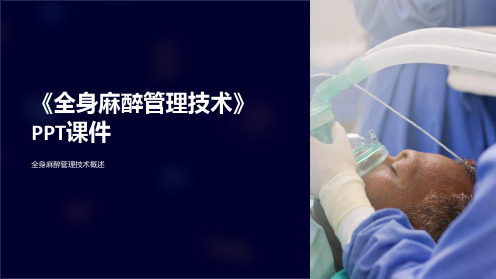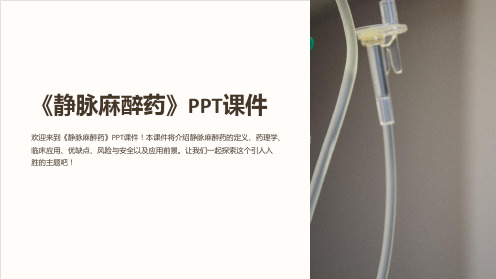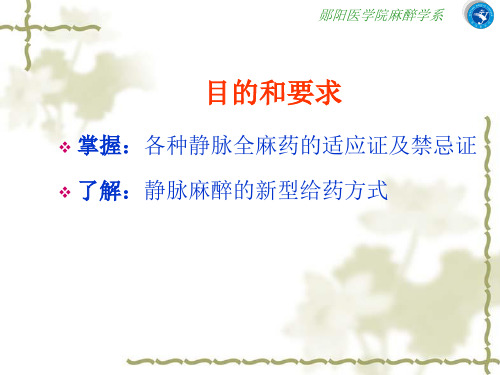静脉全身麻醉PPT课件
合集下载
《全身麻醉管理技术》课件

常见并发症
术后呼吸抑制、恶心呕吐、意识障碍等是常见的 麻醉并发症。
风险评估
根据患者的年龄、身体状况、手术类型等因素, 评估手术中出现并发症的风险。
全身麻醉的技术发展和趋势
新型麻醉药物
随着科学技术的进步,新型麻醉药物的研发和使用将进一步改善全身麻醉的效果。
个体化麻醉
根据患者的基因型和生理特征,个体化麻醉将成为未来发展的趋势。
全身麻醉的管理流程和注意事项
1
手术前
评估患者的身体状况,制定个性化的
麻醉诱导
2
麻醉方案,并告知患者术前禁食禁水 的时间。
给予麻醉药物使患者进入麻醉状态,
同时进行气道管理和监测。
3
手术中
根据手术需要,维持患者的麻醉状态
麻醉恢复
4
并管理术中并发症。
监测患者的生命体征,进行麻醉恢复 和术后镇痛管理。
全身麻醉的常见感器和监测技术,全身麻醉的监测将变得更加准确和无创。
总结和展望
全身麻醉管理技术在手术和医疗领域中起着重要的作用。随着技术的发展, 我们可以期待未来的全身麻醉在安全性和效果上的进一步提高。
《全身麻醉管理技术》 PPT课件
全身麻醉管理技术概述
全身麻醉的定义和作用
全身麻醉是一种药物诱导昏迷和无痛的状态,用于手术和其他医疗程序。通 过抑制神经系统的功能,麻醉药物可以产生失去意识和疼痛感觉的效果。
全身麻醉的分类和常用药物
全身麻醉可分为静脉麻醉、吸入麻醉和局部麻醉。常用的全身麻醉药物包括 异丙酚、地氟醚、七氟醚等,根据不同手术和患者的情况选择适合的药物。
(医学课件)静脉全身麻醉

04
静脉全身麻醉的风险与并发症
呼吸系统并发症
支气管痉挛
由于个体差异或药物过敏,全麻过程中可能出现支气管痉挛,患者表现为呼吸困难、喘息 等症状,需要使用支气管扩张药和糖皮质激素等紧急处理。
肺不张
全麻后,部分患者可能出现肺不张,即肺部分或全部不扩张,导致呼吸困难。此时需要鼓 励患者咳嗽、咳痰,保持呼吸道通畅。
《(医学课件)静脉全身麻醉 》
2023-10-26
目录
• 静脉全身麻醉简介 • 静脉全身麻醉的药物学原理 • 静脉全身麻醉的临床应用 • 静脉全身麻醉的风险与并发症 • 静脉全身麻醉的未来发展趋势与展望
01
静脉全身麻醉简介
定义与背景
静脉全身麻醉是一种常见的麻醉方式,通过静脉注射药物, 使患者失去意识、感觉和运动能力,以达到手术或治疗过程 中无痛觉、不知晓和不记忆的效果。
THANKS
谢谢您的观看
静脉全身麻醉常用于手术、无痛胃肠镜检查、无痛人流等医 疗场景,具有起效快、易于控制、安全性高等优点。
麻醉过程与步骤
麻醉前评估
对患者进行身体状况、病史、过敏 史等评估,确定是否适合进行静脉 全身麻醉。
麻醉诱导
给予镇静药、镇痛药、肌松药等, 使患者失去意识、感觉和运动能力 。
麻醉维持
持续监测患者的生命体征,根据手 术需要给予适量的麻醉药物维持。
心肌梗死
极少数患者全麻后可能出现心肌梗死,此时应立即抢救,包括心肺 复苏、溶栓治疗等。
其他并发症与处理
恶性高热
这是一种遗传性疾病,多在麻醉后出现,表现为高热、高代谢状态、肌肉强 直、酸中毒等。一旦确诊,需要立即抢救,包括给予丹曲林钠、降温、纠正 酸中毒等措施。
苏醒延迟
《静脉麻醉药》课件

静脉麻醉药的药理学
1 药理学原理
静脉麻醉药通过影响神经传递和神经调节来 产生麻醉效果。
2 作用机制
静脉麻醉药的作用机制包括GABA能、离子通 道和受体调节等。
静脉麻醉药的应用
1
临床应用
静脉麻醉药在手术、镇痛和重症监护等领域有广泛的应用。
2
注意事项
在使用静脉麻醉药时,需要注意剂量和患者的个体差异。
总结
• 静脉麻醉药的应用前景广阔,可以在不同领域中发挥重要作用。 • 未来的发展趋势包括更安全的药物研发和个体化麻醉方案。
常用的静脉麻醉药
常用的静脉麻醉药有哪些
常见的静脉麻醉药包括丙泊酚、异丙酚、芬太尼等。
优缺点和适应症
每种静脉麻醉药都有其特点和适应症,需要根据具体情况选择使用。
静脉麻醉药的风险与安全
1
主要风险
静脉麻醉药使用可能存在过敏反应Байду номын сангаас呼吸抑制等风险。
2
如何确保静脉麻醉药的安全使用
严格遵循使用指南、监测患者状况以及合理调整剂量。
《静脉麻醉药》PPT课件
欢迎来到《静脉麻醉药》PPT课件!本课件将介绍静脉麻醉药的定义、药理学、 临床应用、优缺点、风险与安全以及应用前景。让我们一起探索这个引人入 胜的主题吧!
什么是静脉麻醉药
定义
静脉麻醉药是一种用于通过静脉注射来诱导和维持全身麻醉的药物。
分类
静脉麻醉药根据其化学结构和作用机制可分为不同类别。
全身麻醉(医学课件)

04
全身麻醉的监测与护理
麻醉前评估与准备
评估患者身体状况
麻醉前用药
对患者进行全面的身体检查,了解其 健康状况、病史、药物过敏史等信息, 以便评估全身麻醉的风险。
根据患者的具体情况,医生可能会开 具一些麻醉前用药,如镇静剂、镇痛 药等,以缓解患者的焦虑和疼痛。
禁食禁饮
在全身麻醉前,患者需要遵循严格的 禁食禁饮指南,以减少麻醉过程中发 生呕吐和误吸的风险。
麻醉过程中的监测
生命体征监测
在全身麻醉过程中,需要对患者的生命体征进行实时监测,包括 心率、血压、呼吸频率、血氧饱和度等指标。
麻醉深度监测
通过监测麻醉药物的浓度和患者的生理反应,医生可以判断麻醉深 度,从而调整麻醉药物的用量。
呼吸管理
全身麻醉需要使用呼吸机辅助患者呼吸,因此需要对患者的呼吸进 行严密监测和管理,确保呼吸道的通畅和氧气的供应。
总结词
全身麻醉的安全性及有效性是医学界关注的重点,也是未来研究的重要方向。
详细描述
随着手术量的增加和复杂性的提高,全身麻醉的安全性和有效性显得尤为重要。科研人员正在通过临床试验、大 数据分析等方法,深入研究和评估全身麻醉的安全性和有效性,以提高手术的安全性和成功率。同时,也在探索 如何减少全身麻醉的副作用和风险,为患者提供更加安全、可靠的麻醉服务。
THANKS
感谢观看
复合麻醉药
如咪达唑仑、芬太尼等,常与其他 麻醉药物联合使用,增强麻醉效果。
麻醉药物的给药方式
吸入给药
通过面罩或麻醉机将麻醉 气体或挥发性麻醉剂输送 给患者。
口服给药
某些麻醉药物可以口服给 药,但吸收速度较慢,起 效时间长。
静脉给药
通过注射方式将麻醉药物 注入患者的静脉血管。
静脉全身麻醉Intravenousanesthesia

郧阳医学院麻醉学系
Advantages
❖ Rapid induction of anesthesia ❖ Non-irritant to the respiratory tract ❖ No environmental pollution ❖ Making patient comfortable ❖ Rapid recovery ❖ Simply to use (特点: 诱导迅速、对呼吸道无刺激性、病人舒适、
靶控输注
(target-controlled infusion, TCl)
❖ 根据不同静脉麻醉药的药代动力和药效学,以 及不同性别、不同年龄和不同体重病人的自身 状况,通过调节相应的目标血药浓度以控制麻 醉深度的计算机给药系统
郧阳医学院麻醉学系
第一节 硫喷妥钠静脉麻醉
(Intravenous Anesthesia of Thiopentone Sodium)
郧阳医学院麻醉学系
(一)、麻醉体征
神志、循环和呼吸功能、对疼痛的反应以及眼球、瞳孔和对 光反应 ❖ 第一期:大脑皮质轻中度抑制,语言不正确,意识模糊 ❖ 第二期:大脑皮质和皮质下中枢抑制,神志消失,无兴奋征 象,对痛觉敏感,不能施行手术 ❖ 第三期:中枢其他部位直至延髓依次抑制 1级适用麻醉诱导;2级可作体表小手术;3级系麻醉过深 ❖ 第四期:延髓完全抑制。呼吸先停止,同时肌肉松弛,血压 剧降,脉搏细弱,最后心脏停搏
2.5%,15-20 mg/kg, i.m
---- induce sleep in 5 min
5-10%,44 mg/kg, rectal
administration
---- induce sleep in 10-15 min
郧阳医学院麻醉学系
《静脉全身麻醉》课件

检查操作
适用于无痛胃肠镜、无痛 人流等需要镇静的医疗操 作。
其他
还可用于危重患者的镇静 和生命支持。
02
静脉全身麻醉的原理
药物作用机制
镇静药
使患者进入睡眠状态,减轻焦虑和恐 惧。
肌松药
使肌肉松弛,便于气管插管和手术操 作。
镇痛药
抑制疼痛信号的传递,减轻或消除疼 痛。
麻醉过程
麻醉诱导
通过静脉注射麻醉药物, 使患者迅速进入麻醉状态 。
。
循环监测
监测患者的血压、心率 等指标,评估患者的循
环功能状态。
神经功能监测
在手术过程中,监测患 者的神经功能,防止神
经损伤。
03
静脉全身麻醉的方法
诱导期
麻醉诱导
通过静脉注射麻醉药物,使患者 意识逐渐消失,进入手术状态。
监测生命体征
诱导期间需密切监测患者的心率、 血压、呼吸频率等生命体征指标, 确保患者安全。
呼吸道梗阻
由于麻醉药物引起的呼吸道肌肉松弛,可能导致呼吸道梗阻,如喉 痉挛、舌后坠等。
肺部感染
由于麻醉过程中气管插管和机械通气等操作可能增加肺部感染的风 险。
循环系统并发症
低血压
麻醉药物可能导致血管扩张和心肌抑制,引起血压下降。
心律失常
麻醉药物可能对心脏电生理产生影响,导致心律失常,如心动过 缓、室性早搏等。
苏醒期
麻醉苏醒
逐渐减少麻醉药物的输注,使患者意识逐渐恢复 。
拔除气管导管
当患者意识恢复良好,能够自行呼吸且呼吸道通 畅时,拔除气管导管。
观察和护理
在苏醒期间,需密切观察患者的情况,确保生命 体征平稳,做好护理工作。
04
静脉全身麻醉的风险与并发症
全身麻醉PPT课件PPT41页

第23页,共41页。
通用临床麻醉深度判断标准
麻醉分期 浅麻醉期
手术麻醉期 深麻醉期
呼吸
Hale Waihona Puke 循环不规则,呛咳, 血压↑,心率↑ 气道阻力↑, 喉痉挛
规律,气道阻 力↑
膈肌呼吸,呼 吸↑
血压稍低但稳 定,手术刺激 物改变
血压↓
眼征
其他
睫毛反射(-),吞咽反射
眼睑反射
(+),出汗,
(+),眼球 分泌物↑,刺
第8页,共41页。
第一节 全身麻醉药
一、吸入麻醉药
(三)代谢和毒性 绝大部分由呼吸道排出,小部分在体内代谢后随尿排出 主要代谢场所是肝脏,细胞色素P450是重要的药物氧化代谢酶
有些药物具有药物代谢酶诱导作用,可加快自身代谢速度
产生毒性的原因主要是血中无机氟(F-)浓度的升高。 (低于50umol/L无肾毒性;50~100umol/L有引起肾毒性的可能; 高于100umol/L肯定产生肾毒性)
痰管超时限吸引,可引起病人SaO2显著下降。 • 6 其他 如病人的寒战可使氧耗量增高500%,对存在肺内分
流的病人PaO2下降。
第32页,共41页。
处理
1 持续脉搏血氧饱和度、PetCO2和PaCO2的监测 2 以下病人即使其PaO2处于正常范围,但是仍有发生组织低氧或缺氧
的可能:
(1) 低血容量(低CVP、少尿)
肝内水解,代谢物无活性,对肝肾功能无明显影响
临床应用:全麻诱导 副作用:肌阵挛;对静脉有刺激性;术后易恶心、呕吐;反复 用药或持续静滴后可能抑制肾上腺皮质功能
第14页,共41页。
第一节 全身麻醉药
二、静脉麻醉药
4、丙泊酚(异丙酚):
通用临床麻醉深度判断标准
麻醉分期 浅麻醉期
手术麻醉期 深麻醉期
呼吸
Hale Waihona Puke 循环不规则,呛咳, 血压↑,心率↑ 气道阻力↑, 喉痉挛
规律,气道阻 力↑
膈肌呼吸,呼 吸↑
血压稍低但稳 定,手术刺激 物改变
血压↓
眼征
其他
睫毛反射(-),吞咽反射
眼睑反射
(+),出汗,
(+),眼球 分泌物↑,刺
第8页,共41页。
第一节 全身麻醉药
一、吸入麻醉药
(三)代谢和毒性 绝大部分由呼吸道排出,小部分在体内代谢后随尿排出 主要代谢场所是肝脏,细胞色素P450是重要的药物氧化代谢酶
有些药物具有药物代谢酶诱导作用,可加快自身代谢速度
产生毒性的原因主要是血中无机氟(F-)浓度的升高。 (低于50umol/L无肾毒性;50~100umol/L有引起肾毒性的可能; 高于100umol/L肯定产生肾毒性)
痰管超时限吸引,可引起病人SaO2显著下降。 • 6 其他 如病人的寒战可使氧耗量增高500%,对存在肺内分
流的病人PaO2下降。
第32页,共41页。
处理
1 持续脉搏血氧饱和度、PetCO2和PaCO2的监测 2 以下病人即使其PaO2处于正常范围,但是仍有发生组织低氧或缺氧
的可能:
(1) 低血容量(低CVP、少尿)
肝内水解,代谢物无活性,对肝肾功能无明显影响
临床应用:全麻诱导 副作用:肌阵挛;对静脉有刺激性;术后易恶心、呕吐;反复 用药或持续静滴后可能抑制肾上腺皮质功能
第14页,共41页。
第一节 全身麻醉药
二、静脉麻醉药
4、丙泊酚(异丙酚):
《全身麻醉》课件

制定个性化计划
麻醉师会根据患者的状况和手术 类型,制定个性化的麻醉计划。
建立团队合作
医生、麻醉师和护士等人员需要 密切合作,确保手术的安全和顺 利进行。
探索全身麻醉的魅力
欢迎来到全身麻醉的世界,你将了解到麻醉的定义,作用和流程,还有如何 提高麻醉的效果和安全性。
全身麻醉的定义
全身麻醉是指将患者引入无意识的状态,通过药物来达到无痛、无意识的治 疗目的。它是外科手术中最常用的麻醉方式。
全身麻醉的作用与意义
无痛手术
全身麻醉让你无感知,使手 术过程更加安全,避免疼痛 和焦虑。
麻醉师会不断监测患者的各项 生理指标,确保手术安全进行。
注射麻醉药
在患者睡着之后,麻醉师会逐 渐注射麻醉药物,确保患者的 全身麻醉状态。
全身麻醉相关风险与并发症
1 恶心和呕吐
全身麻醉后有可能出现恶 心和呕吐,但是这很常见 并且可以通过药物缓解。
2 低血压
全身麻醉可能会导致患者 血压下降,但是这也可以 通过适当的药物和流体管 理来处理。
全身麻醉的前期准备工作
身体检查
医生会检查患者的身体情况, 比如血压、心率等。
麻醉咨询
麻醉师会与患者进行详细的咨 询,以了解患者的病史和用药 情况。
必要的准备
医生会让患者保持空腹,脱除 饰物和器具等,以便进行手术。
如何提高全身麻醉的安全性和效果
定期检查设备
麻醉设备需要经常进行检查和校 准,以保证其正常工作。
便于手术
全身麻醉有利于手术的进展 和完成,同时也便于医生进 行细致的操作。
同时进行其他操作
在全身麻醉的情况下,可以 同时进行其他的检查和治疗, 如取样、置管等。
全身麻醉的步骤与流程
- 1、下载文档前请自行甄别文档内容的完整性,平台不提供额外的编辑、内容补充、找答案等附加服务。
- 2、"仅部分预览"的文档,不可在线预览部分如存在完整性等问题,可反馈申请退款(可完整预览的文档不适用该条件!)。
- 3、如文档侵犯您的权益,请联系客服反馈,我们会尽快为您处理(人工客服工作时间:9:00-18:30)。
-
9
(二)适应症 1、适用于短小手术
(short procedures or induction of anesthesia、
2、全麻诱导(induction)、
3、控制痉挛和惊厥(anesthesia maintain)、
4、颅脑手术:降低颅内压(reduction of intracranial pressure) 。
-
8
第二节硫喷妥钠静脉全麻
硫喷妥钠(thiopental sodium ) :巴比妥类静脉全麻药 特点:优点:起效快、维持时间短、操作管理方便 缺点:麻醉效果不完善、清醒不完全、呼吸循环抑制、 呼吸道分泌物增多 (一)麻醉方法 可单次(bolus):用于短小手术麻醉诱导 分次 (interminttent injection):短的浅表手术 连续滴入(continous infusion).
-
5
(三) 根据用药方法分类:
单次(bolus induction of anesthesia)、 分次(intermittent injection)、 连续给药(continuous infusion )、 泵输注(target controlled infusion TCI)。 根据用药种类:单一、复合。 平衡麻醉:镇静+镇痛+肌松
第七章 静脉全身麻醉
全麻药注入静脉,通过血液循环,作用 中枢系统,使意识消失,周身不感疼痛。
General anesthesia maybe produced by many drugs which are administered by intravenous injection and depress the central nervous system .
-
11
(四)并发症 1、局部刺激 2、动脉炎 3、抑制循环系统 4、抑制呼吸系统 5、过敏反应
-
12
第三节芬太尼及其衍生物静脉麻醉
一、芬太尼
起效快、作用时间短、容易控制.对循环影响轻微 1.analgesia potency is powerfull 2.onset of action is rapid 3.cardiovasculardepression is slight
-
10
(三)禁忌症 1、婴幼儿 2、产妇或剖宫产 3、不能用于心衰(cardiac failure )、 4、休克(shock)、 5、呼吸道梗阻(airway obstruction)、 6、哮喘(asthmas)、 7、饱胃患者(full )、 8、咽喉部肛门手术(largeal pharax )、 9、巴比妥过敏。
(一)适应症和麻醉方法 1、全身麻醉诱导 2、全身麻醉维持 3、大剂量芬太尼复合麻醉 4、MAC
-
13
Dose and administration Indution of anesthesia 6-8ūg/kg,10-20ūg/kg for cardiovascular surgery Maintance of anesthesia Total dosage may up to 50-100ūg/kgfor cardiovascular surgery.
-
14
Indications
Introduction of anesthesia Sedation and anesthesia Cardiac vascular surgery Trauma General Surgery Neurosurgery
-
15
(二)注意事项 循环系统 呼吸系统 肌肉僵硬 恶心、呕吐
-
3
二、静脉全身麻醉分类
分类(classification principal) :
(一) 根据所用药物分类 麻醉药分类:
巴比妥类—硫喷妥钠 非巴比妥类 苯二氮卓类—安定 阿片类— 吗啡
-
4
(二)根据临床应用 静脉诱导、静脉维持、静脉基础。 1.intravenous induction of anesthesia 2.intravenous maintain of anesthesia, 3.intravenous basal anesthesia。
-
16
二 舒芬太尼
特点
1、镇痛作用最强(芬太尼的5-10倍)
2、镇痛时间长(芬太尼的2倍)
3、对循环、呼吸影响更轻微
三 瑞芬太尼
特点
1、镇痛作用相当于芬太尼
2、作用时间短、恢复迅速无蓄积,适合门诊小 手术.
3、收缩脑血管、降颅压,适合颅脑手术.
4、停药后疼痛发生早-.
17
第四节 丙泊酚静脉麻醉
-
三、监测下的麻醉管理(MAC)
主要工作内容 1、监测重要生命体征、
维护呼吸道通畅和评估其功能 2、诊断和处理MAC中的临床问题 3、根据临床情况给予镇静药、
镇痛药、麻醉药以及其他合适药物 4、其他所需医疗服务措施.
-
7
四、静脉全身麻醉的药物输注系统
(一)滴注泵和输注泵 (二)靶控输注系统(TCI) (Target controlled infusion.TCI).
(intravenous anesthesia of propofol )
-
1
第一节 概述
一静脉全身麻醉的特点
(一)优点: 1、起效快,效能强. 2、病人依从性好.病人舒适; 3、药物种类齐全对呼吸道无刺激; 4、无污染和燃烧爆炸; 5、麻醉效应可逆转. 6、操作简单.
Advantage
1.Rapid induction of anesthesia
2.Non irritant to the respiratory tract
3.No enviremental pollution
4.Making patient comfortable
5.Rapid recovery
-
2
(二)缺点: 可控性差: 入血不易排除,麻醉效应依赖肝肾功能; 麻醉深度不易控制,需要复合给药;肌松差 麻醉效能弱;对呼吸循环有一定程度的抑制 Disadvantage 1. .poor control 2.no muscle relaxation 3.poor analgesia
